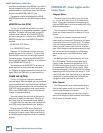
27
Compact Mixer Reference Guide
MIXER ANATOMY: CHAPTER 2
PPM Series Outputs
The PPM mixers have two power amplifi ers built
in. A fl exible arrangement of switches and jacks allow
you to use those two amplifi ers for any combination
of main and monitor speakers.
SPEAKER Out (PPM)
These 1/4" TS jacks carry the outputs of the power
amplifi ers.
There’s power behind these jacks – 125
to 600 watts depending on the model.
Don’t connect them to anything other than
passive speakers – not active speakers, not a record-
er, not another mixer. PASSIVE SPEAKERS ONLY!
Caution: Don’t use standard guitar
cables to connect your speakers. Guitar
cords are designed for line level signals
and low currents, not the high currents and voltages
of speaker levels. Use heavy duty speaker cables—at
least 16 gauge. The heavier (lower gauge number)
the better. Thin speaker cables equal thin sound!
There are two SPEAKER OUT jacks for each ampli-
fi er. The jacks are wired in parallel.
When you connect two speakers to a single ampli-
fi er, the load presented to the amplifi er is the parallel
impedance of both speakers. The total (parallel)
impedance must be two ohms or greater.
• Two 8 ohm speakers in parallel equals 4 ohms.
• Two 4 ohm speakers in parallel equals 2 ohms.
The general formula for impedance in parallel is:
In electronics, Z is the symbol for impedance. We
don’t have a clue as to what word Z stands for.
Can you plug speakers with different impedances
into the two jacks same amplifi er? Sure, as long as
the total impedance isn’t lower than 2 ohms. Chances
are, however, that the effi ciency of the speakers will
be different enough that they’ll produce noticeably
different volumes. This may or may not be what you
want.
Note that the stereo and mono PPM mixers have
different labels on the speaker connectors. They also
have different options for routing MAIN and MONI-
TOR mixes to those two amplifi ers.
There’s a convenient pushbutton to select the
most common confi gurations. There are also patch-
ing jacks that allow you to rearrange things to your
liking, or add an external power amplifi er for more
fl exibility. See the PPM Applications for some sugges-
tions
On the stereo mixers, the choices for Power Amp
routing are:
POWER AMP ROUTING - In
AMP 1 – MAIN Mono (left + right)
AMP 2 – Monitor
Or
POWER AMP ROUTING - Out
AMP 1 – MAIN Left Channel
AMP 2 – MAIN Right Channel
On the mono mixers, the choices are:
POWER AMP ROUTING - In
AMP 1 – MAIN
AMP 2 – Monitor
Or
POWER AMP ROUTING - Out
AMP 1 – MAIN
AMP 2 – MAIN
On both the mono and stereo models, when the
ROUTING switch is in the Out position, both power
SPEAKER OUT
OUTPUT POWER: 250 WATTS / CHANNEL
MINIMUM SPEAKER LOAD: 2 OHMS / CHANNEL
SPEAKER OUT
POWER AMP 1 / MAIN
POWER AMP 2 / MONITOR
EFX FOOT
SWITCH
RIGHT RETURNLEFT RETURN
SEND
L MIXER OUT R MIXER OUT COMPRESSOR
L POWER
AMP IN
R POWER
AMP IN
EFFECTS
(OVERRIDES INTERNAL EFX)
MONITOR
MAINS
LINE
OUT
408S
POWER AMP ROUTING
IN
OUT
STEREO MAINS
LEFT = MAIN
RIGHT = MONITOR
2 X 250W STEREO
EFX FOOT
SWITCH
RETURN
SEND
MIXER LINE OUT
POWER
AMP 1 IN
POWER
AMP 2 IN
EFFECTS
(OVERRIDES INTERNAL EFX)
MONITOR
MAINS
LINE
OUT
POWER AMP ROUTING
AMP 1
MAIN
MAIN MONITOR
AMP 2
MAIN
COMPRESSOR
IN
OUT
2 X 250 WATTS
408M
Z
1
1
Z1
+
1
Z2
+
1
Z3
etc.
















